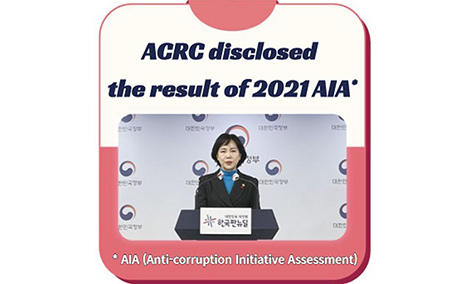ACRC publicized the result of the 2021 Anti-corruption Initiative Assessment(AIA)
- Date2022-02-15
- Hit2,082
ACRC publicized the result of
the 2021 Anti-corruption Initiative Assessment(AIA)
- The institutions receiving increased AIA grades due to active anti-corruption efforts showed improved integrity levels –
-The significance and influence of the anti-corruption efforts of public institutions will rise because of the newly introduced “Comprehensive Integrity Assessment” this year -

ACRC Chairperson disclosing the results of the 2021 AIA
The Anti-Corruption and Civil Rights Commission (ACRC) announced the results of the “Anti-Corruption Initiative Assessment (AIA)” conducted for 273 public institutions, including central government agencies, local autonomous governments, offices of education, and public service-related organizations.
※ The assessment results of target institutions (on 7 unit tasks and 19 indicators) were announced as the integrity level (grade 1 to 5)
Through the AIA that evaluates the anti-corruption efforts and achievements of public institutions every year since 2002, the ACRC has supported public institutions to voluntarily push forward their anti-corruption policies.
The result of this assessment revealed that the more increased grade a public institution received in the AIA due to its active anti-corruption efforts, the more meaningful co-relation it shows between its AIA result and the result of the “Integrity Assessment for public institutions(IA)” released in December last year.
The public institutions(63 institutions*) receiving enhanced grades in the 2021 AIA showed improvement in all Comprehensive Integrity Level (+0.12 points), External Integrity Level (+0.15 points), and Internal Integrity Level (+0.05 points). In particular, the institutions that improved by more than two grades in the AIA showed a relatively larger improvement (+0.16 points) in the Comprehensive Integrity Level than those that went up one grade (+0.11 points).
* The AIA results were analyzed for a total of 203 institutions that were assessed for two consecutive years, excluding the 70 institutions that were not subject to the 2020 AIA, and national/public universities and public health institutions for which different assessment models were applied.
On the other hand, the institutions with lowered grades in the AIA showed relatively sharp drops in all Comprehensive Integrity Level (-0.11 points), External Integrity Level (-0.09 points), and Internal Integrity Level (-0.06 points).
The average score of all the target institutions was 84.7 out of 100 points and the score for municipal and provincial education offices was the highest (88.8 points), followed by public service-related institutions (87.0points), metropolitan/provincial governments (86.6 points), and central administrative agencies (85.6 points). The result also revealed that local district governments (79.8 points), national/public universities (77.5 points), and public health institutions (76.7 points), which showed low scores, need to make further efforts.
Moreover, according to the analysis of the results by institution type, the types with a higher AIA score also showed a higher Integrity Level. Therefore, it was revealed that the institutions that make efforts to actively push forward initiatives following the direction of the government’s anti-corruption policies also have generally outstanding integrity levels and perceptions internally and externally.
※ (Integrity Level) Municipal and provincial education offices (8.54 points)>public service-related institutions (8.51 points) >central administrative agencies (8.29 points)> metropolitan/provincial governments (8.14 points) >local district governments (8.03 points)
※Among all the institution types, metropolitan/provincial governments showed the largest increase in Comprehensive Integrity Level (+0.12 points)
In the assessments by unit task, the best result was shown in the task of “Operation of anti-corruption institutions,” which assesses the performance in operating laws and institutions such as integrity education, code of conduct, recovery of public funds, and the Improper Solicitation and Graft Act, etc., followed by the task of “Effort to spread anti-corruption policies,” which includes the indicators on activities to spread the culture of integrity and efforts to share and disclose anti-corruption information.
On the other hand, it was revealed that the score of the task, “Establishment of anti-corruption institutions” was low, meaning that public institutions need to make further efforts to implement the ACRC’s recommendations on institutional improvements in preventing corruption.
Also, it was revealed that some institutions didn’t follow the protective provisions for corruption and public interest reporters, violating the obligation to maintain the confidentiality of personal information of reporters, for example, or didn’t implement legal protective measures such as decision to protect reporters. These cases led to deduction of points, requiring more attention from public institutions.
|
Planning |
Implementation |
Achievement/wider adoption |
Deduction |
Total |
||||
|
Establishment of anti-corruption implementation plan |
Expansion of participation in integrity policies |
Establishment of anti-corruption institutions |
Efforts to eradicate corruption risks |
Operation of anti-corruption institutions |
Outcome of anti-corruption Policies |
Efforts to spread anti-corruption policies |
||
|
85.0 |
77.5 |
75.8 |
81.3 |
97.0 |
79.1 |
91.6 |
-0.06 |
84.7 |
An ACRC Official said, “Despite the pandemic situation caused by COVID-19, most public institutions systematically established and implemented their annual anti-corruption plans and made best efforts to publicize the achievements to the people.”
An ACRC Official added, “As the assessment system will be reorganized this year, in the way that anti-corruption initiative efforts of public institutions are directly reflected in the Comprehensive Integrity Level, the importance and influence of the assessment will also be enhanced significantly. Therefore, I would like to ask all public institutions to make active anti-corruption efforts to raise the integrity level of the public sector.”
|
Attachment 1 |
Comparison of the Integrity Assessment Measures before and after the reorganization |
|||||||||||||||||||
|
|
||||||||||||||||||||
|
Section |
Before reorganization |
After reorganization (2022 ~) |
|
|||||||||||||||||
|
Assessment Measures |
• Adual assessment system to operatethe Integrity Assessment and the Anti-corruption Initiative Assessment separately - Integrity Assessment (maximum 10 points), Anti-corruption Initiative Assessment (maximum 100 points) |
▸Integrated assessment system (Comprehensive Integrity Assessment)
|
|
|||||||||||||||||
|
•Separate publicationof the results -Integrity Assessment: December, Anti-corruption Initiative Assessment: January ~ February of the following year |
▸Publication of the 2022 assessment results: January ~ February 2023 |
|
||||||||||||||||||
|
Target Institutions |
•Integrity Assessment: Annual assessment of appx. 700 institutions
•Anti-corruption Initiative Assessment: Annual assessment of appx. 270 institutions - Most basic local governments and small-scale quasi-government agencies do not conduct the Anti-corruption Initiative Assessment. |
▸Target institutions for annual assessment (appx. 500 institutions)
- (Annual assessment) Central administrative agencies, metropolitan/local governments, municipal and provincial education offices, public organizations, quasi-government agencies, and metropolitan local councils - (Additional assessment) Local public corporations, other public organizations, basic local councils, national/public universities, public health institutions, etc. |
|
|||||||||||||||||
|
•For central administrative agencies and public service-related organizations among the target institutions of the Integrity Assessment, the institution types are subdivided depending on the number of employees of the institutions. |
▸The institution types are recategorized, depending on the nature and functions of the institutions. - (Central agencies) Minister-level agencies / Vice Minister-level agencies - (Public service) Public companies/ quasi-government institutions/ local public corporations/ national & public universities/ public health institutions/ other public service-related organizations |
|
||||||||||||||||||
|
Assessment Indicators |
•Integrity Assessment (Survey):
|
▸Integrity Perception Level (60%)
|
|
|||||||||||||||||
|
•Anti-Corruption Initiative Assessment: Same indicators are used for all target institutions - A total of 19 indicators were used for the areas of “Planning – Implementation – Achievement and Wider Adoption” and deduction |
▸Integrity Effort Level (40%): Application of customized and phased indicators and introduction of assessment for initiative effectiveness - A total of 15 indicators are used (about half the number for small-scale institutions) |
|
||||||||||||||||||
|
Assessment Methods |
|
▸Integrity Perception Level: Survey (Citizens who experienced public service, Internal employees)
|
|
|||||||||||||||||
|
• Anti-Corruption Initiative Assessment: quantitative & qualitative assessment by indicator
- 3 ~ 15 points per indicator (gap among indicators↑) |
▸ Integrity Effort Level: quantitative & qualitative assessment + effectiveness assessment
- 5 ~ 10 points per indicator (gap among indicators↓) |
|
||||||||||||||||||
|
Deduction |
• Deduction for corruption cases - Deduct points of maximum 7% from the final result of the Integrity Level (maximum 10 points) (Extra deduction for key corruption cases through qualitative assessment)
- Limited opportunities for public institutions to give feedback (only available by media coverage) |
▸Corruption Realities - Comprehensively deduct points of maximum 10% (10 points) from the final result of Perception Level and Experience Level (maximum 100 points)
- Opportunities to confirm and vindicate alleged corruption cases run twice to improve the accuracy |
|
|||||||||||||||||
|
• Any action to undermine reliability
- Sanction standards are applied only in the Integrity Assessment |
▸Any action to undermine reliability and fairness of the assessment - Sanction standards are created and applied for such actions occurred during the whole assessment process of Perception Level, Effort Level, and Corruption Realities |
|
||||||||||||||||||













